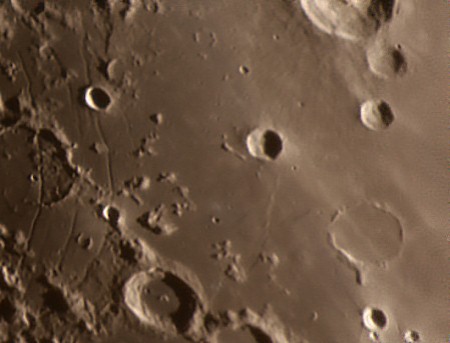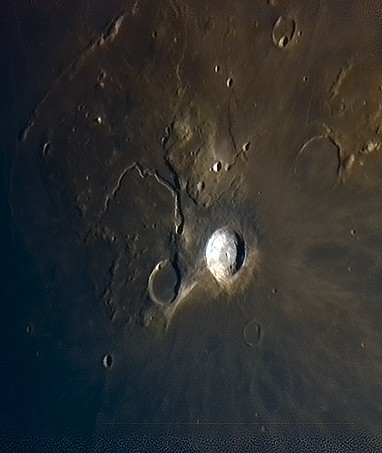Near Bullialdus crater (at top-right side of the picture) there is a quite interesting region called Rimae Hippalus. Hippalus crater is the big one (left-center side of the picture). It is a big crater. In this image, shadows in this crater due to a low altitude sunlight creates a visual effect, as if a great creature had stamped his bare footprint in lunar soil. Do you see it?
Archive for Newtonian
Moon scratched by the claw of a bear
Posted in Astrophotography with tags Astronomy, Astrophotography, Bullialdus crater, Canon EOS 450D, Manual-Crazy-Tracking, Meade Lightbridge 16", Moon, Newtonian, no tracking, Reflex, Registax, Rimae Hippalus, Telescope on 2011/08/31 by computerphysicslabAristarchus crater (Moon) with Meade Lightbridge 16 inch
Posted in Astrophotography with tags Astronomy, Astrophotography, Canon EOS 450D, crater, Manual-Crazy-Tracking, Meade Lightbridge 16", Moon, Newtonian on 2011/04/17 by computerphysicslabAristarchus crater (Moon) with Meade Lightbridge 16 inch:
Aristarchus is a large impact crater on the Moon, is in the northwest of the nearside of the Moon. It is considered the brightest of the large formations on the lunar surface, its albedo is nearly double that of most other geographical spots. The crater is bright enough to be visible to the naked eye and is stunning when viewed through a large telescope. It is also easy to identify when most of the lunar surface is illuminated by reflection of light on Earth.
The crater is located on the southeast edge of the Aristarchus Plateau, an area that contains several high volcanic features, such as wrinkling rimes. This area is known for it have been detected in a significant number of transient lunar phenomena of nature as well as by recent emissions gas radon to be measured by the spacecraft Lunar Prospector.
A very fast Lightbridge 16 review
Posted in Astrophotography with tags Collimation, Meade Lightbridge 16", Newtonian, Telescope on 2009/11/06 by computerphysicslabHello, Id like to ask a question about your experience with the 16″ Lightbridge. I’ve read some good reviews and bad reviews about it. I’ve read that it is very hard to collimate and that the focuser may not come perfectly perpendicular to the tube assembly from the factory and may need shimming to properly align it.
I’d like to know your opinion on these things and also the quality of the focuser. Is there much flex in the trusses? Have you been able to attain crisp clear focus? Would you recommend this scope, or to rather spend an extra $1000 to get a similar sized Discovery scope?
Thanks!
-Joey
————————————————–
Collimation is an important issue when observing through Meade Lightbridge 16″. Mainly for planets and Moon, because a good collimation gives much better images at high magnification. When moving the telescope, it is usual to get discollimation, so every time you move it, you firstly have to collimate it before observing.
Another disadvantage of this telescope is its weight. It weights a lot and it is not easy to move from one place to another.
Nevertheless starfield views are incredible due to its high aperture, mainly under dark skies. It becomes very easy to observe deep sky objects. It is impressive to observe Dumbell nebula at 200x.
To attain crisp clear focus is very difficult when observing planets or the Moon due to atmospheric turbulence. 16 inches of aperture are very sensitive to turbulence.
I would recommend the telescope if you are planing to be observing always at the same place. It is a very cheap telescope taking into account its aperture.
I cannot talk about Discovery telescope, because I have never watched through one of them.
Regards,

Polaris A & Polaris B
Posted in Astrophotography with tags afocal, Astronomy, Canon EOS 450D, Deep sky, Newtonian, no tracking, Polaris, Polaris A, Polaris B, Rebel XTi, Reflex on 2009/10/18 by computerphysicslabPolaris has a close neighbor at 18 arcseconds that can be spotted easily through a telescope.

This is a 15 seconds exposure through a Meade Lightbridge 16-inch, a Dobson with no tracking, but fortunately Polaris moves very slowly through its small circumpolar path, due to its proximity to north pole in the sky. The camera used was a Canon EOS 450d, also known as Rebel XTi. The method employed was an eyepiece projection using a 14mm Meade Series 5000.
Mare Tranquillitatis in color
Posted in Astrophotography with tags 150/750, afocal, Astronomy, Canon EOS 450D, Manual-Crazy-Tracking, Mare Serenitatis, Mare Tranquillitatis, Moon, Newtonian, Paint Shop Pro, Rebel XTi, Reflector, Registax, Telescope, terminator on 2009/09/11 by computerphysicslabColor contrasts in the Moon are interesting even beautiful. The following picture shows Mare Tranquillitatis area and the southern part of Mare Serenitatis in full color. It was taken 4 days after full moon. The shadows in the terminator show the orography of the landscape. Mare Tranquillitatis seems to be mainly blue. This is due to its peculiar chemical composition.
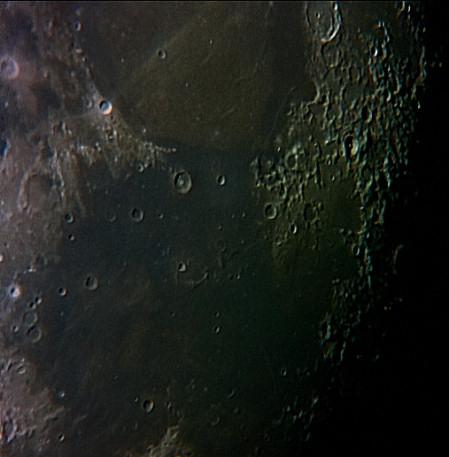
Pitiscus
Posted in Astrophotography with tags 150/750, afocal, Astronomy, Canon EOS 450D, crater, Hommel, Ideler, Manual-Crazy-Tracking, Moon, Newtonian, Noiseware, Paint Shop Pro, Pitiscus, Rebel XTi, Reflector, Reflex, Registax, Spallanzani, Telescope, terminator on 2009/09/09 by computerphysicslabPitiscus, Hommel, Ideler and Spallanzani are the only four craters of the picture with proper name. The rest of them are named by letter surnames like Ideler R or Ideler L. They are located in the South-East area of the Moon. The picture was taken on 2009-09-09 05h 20m U.T. and the terminator was passing across Pitiscus, Hommel, the two big and shadowed craters. Pitiscus is 85 km wide and Hommel is 129 km (76 miles). The smallest craters of the image are 7 km wide, that is 3.5 arcseconds, 1.75 arcseconds for the bright spot and 1.75 arcseconds for the shadow spot. Image detail could then be better for a 6-inch telescope (this is the equipment used to take the image, an scope capable up to 0.7 arcseconds of resolution). 622 subframes were recorded with the Manual-Crazy-Tracking system and stacked in Registax 5.

Posidonius
Posted in Astrophotography with tags 150/750, afocal, Astronomy, Canon EOS 450D, Chacornac, crater, Manual-Crazy-Tracking, Mare Serenitatis, Moon, Newtonian, Noiseware, Posidonius, Rebel XTi, Telescope on 2009/09/08 by computerphysicslabPosidonius is a big crater of the Moon on Mare Serenitatis. There is a lot of interesting details to observe inside: peaks, ridges, craterlets, … In the following image taken yesterday night, 4 km wide craters can be spot as small white points in the smooth surface of Mare Serenitatis.
Posidonius measures 95 km in diameter. The second biggest crater (a bit ghostly) in the picture is Chacornac, just below Posidonius. Inside it is visible a small craterlet called Chacornac A (it measures 5 km in diameter).
The third biggest crater of the picture is Daniell (31 km wide) located in the upper middle side. Its shape is not circular, but oval. This is the cause of a strange effect in perspective when comparing it with the craters nearby.
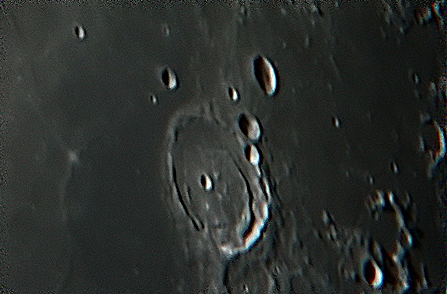
PosidoniusPosidonius is a lunar impact crater that is located on the western edge of Mare Serenitatis
Dorsum Oppel
Posted in Astrophotography with tags 150/750, afocal, Astronomy, Canon EOS 450D, Dorsum Oppel, Manual-Crazy-Tracking, Mare Crisium, Moon, Newtonian, Peirce, Proclus, Swift, Telescope, terminator, wrinkle ridge, Yerkes on 2009/09/07 by computerphysicslabDorsum Oppel is a wrinkle ridge of the Moon in Mare Crisium. 2 days after full moon is the best moment to observe it. It is a very large formation and the landscape along is quite impressive, full of small craters, tiny mountains and the smooth floor of Mare Crisium. It is important to reach a high magnification to enjoy the view (150x at least).
My setup is a 6-inch telescope, but I bet it is possible to observe it comfortably with a 4-inch refractor.

The bright and overexposed crater is Proclus. I have to work harder the dynamic range issue next time.
Swift and Peirce are the pair of craters in the upper side of the picture, near the lunar terminator. Below Peirce should be visible a 2 kms wide craterlet, but unfortunately my picture cannot yield such a resolution. According to a quick calculation, 3 kms is the smallest visible feature in theis image, and that corresponds to 1.5 arcseconds. A bit far still to the maximum theoretical resolution of a 6-inch telescope (that is around 0.7 arcseconds)
Yerkes is the big ghostly crater in the right side. Apparently there is a central peak in its center. I have been looking for a confirmation of the existence of that peak, but I haven’t found any reliable source where it is mentioned. Any hint here, I would be thankful…
Manual Crazy Tracking
Posted in Astrophotography with tags 150/750, afocal, Astronomy, GRS, Jupiter, Manual-Crazy-Tracking, Newtonian, shift-and-add, Telescope, webcam on 2009/09/01 by computerphysicslabLacking of an equatorial mount I have built myself a kind of manual tracking system that keeps into the field of view of a webcam a planet like Jupiter, for 3 minutes. This is long enough to record useful data and then post-process it with aggressive wavelets.
The resulting tracking is not at all perfect. You may see Jupiter swinging around the screen. It is important to capture the data at a fast shutter speed (1/100 sec.) to avoid motion blur in every frame because the planet is always dancing.
In spite of this movement, the results after stacking are very good. Here I show this really simple system and the resulting yesterday’s Jupiter with the webcam:
![]()
![]()
![]()
As you can see the Manual-Crazy-Tracking is a very simple system that consists in a rubber band attached to the tripod handle. If you try to track manually directly pushing the tripod handle, the shaking is excessive and you would need a very very fast shutter speed to get some useful data. The rubber band is necessary to reduce vibrations and increase the shift movement control.
At beginning Jupiter is located in the center of the field of view with no need to any corrections. As long as it drifts due to its sidereal movement you will have to pull using the rubber band in order to keep it in the center of the screen (it is supposed you have a laptop there capturing and showing images from the webcam). This way you may have Jupiter centered in the screen for a long time. You will have time to focus (left hand pulling the rubber band and right hand tweaking the focuser) and time to expose.
Jupiter, Io & Wesley impact scar
Posted in Astrophotography with tags 150/750, afocal, Astronomy, Canon EOS 450D, impact, Jupiter, Newtonian, no tracking, Paint Shop Pro, Registax, scar, shift-and-add, Telescope, Wesley on 2009/08/28 by computerphysicslabGood seeing yesterday too (2009-08-27 23h05m UT). Wesley impact scar is fading day after day, but it is still there. I made an animation that shows Io approaching Jupiter’s limb: http://www.youtube.com/watch?v=78zJtv569y4

Big Jupo
Posted in Astrophotography with tags 150/750, afocal, Astronomy, Canon EOS 450D, EOS Camera Movie Record, Jupiter, Mitchell, Newtonian, no tracking, Paint Shop Pro, Photoshop, Rebel XTi, Reflector, Reflex, resampling, shift-and-add, Telescope, VirtualDub on 2009/08/27 by computerphysicslabI have a good seeing last night. So I got my best Jupiter yet. Here it is:

It is 4x resampled via Registax Mitchell and PS. After resampled I can spot more details in bands and polar zones.
As always I used the 6-inch no-EQ mounted newtonian reflector, the 14mm eyepiece doing afocal projection over the Canon EOS 450d (Rebel XTi) body and recording video using “EOS Camera Movie Record” free software. Three times Jupiter crossed over the field of view. Registax and VirtualDub added and stacked the footage properly.
Ganymede’s shadow
Posted in Astrophotography with tags 150/750, afocal, Astronomy, Canon EOS 450D, Europa, Ganymede, Io, Jupiter, moons, Newtonian, no tracking, Paint Shop Pro, Photoshop, planet, Rebel XTi, shadow, shift-and-add on 2009/08/20 by computerphysicslabYesterday night I had the chance to enjoy a multiple moon transition in Jupiter. Ganymede and Europa were crossing Jupiter and throwing their shadows to the big planet. Here it is an image of the event. At 23h 24m U.T Europa’s shadow was not visible yet. Io also appears at the photo but it was beneath the planet. In a minutes it would disappear.
The picture was taken with my digital reflex body (EOS Rebel XTi) and using the video capture software that converts it into a high quality webcam.
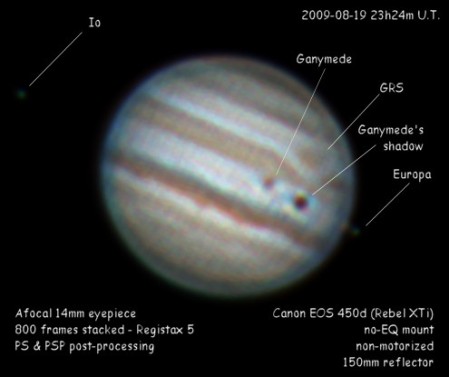
Jupiter Opposition
Posted in Astrophotography with tags 150/750, afocal, Canon EOS 450D, Jupiter, Newtonian, no tracking, Opposition, Paint Shop Pro, Photoshop, Rebel XTi, Reflector, Reflex, shift-and-add, Telescope on 2009/08/17 by computerphysicslab15th August 2009 was the day that Jupiter reached its closest position to Earth. Its apparent diameter was 49 arcseconds, so this is the best time to do planetary astrophotography with the giant planet. Using the afocal technique and a Canon EOS 450d body I took 2 video sequences and processed with Registax 5, Photoshop & Pain Shop Pro.
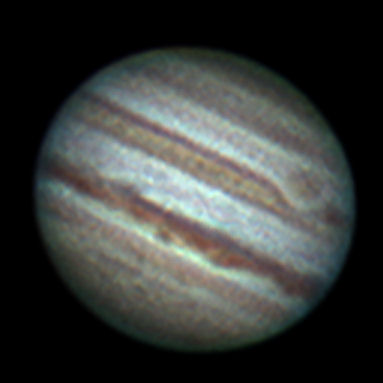
Wesley impact scar
Posted in Astrophotography with tags 150/750, afocal, Astronomy, Canon EOS 450D, GRS, Jupiter, Newtonian, no tracking, Photoshop, Rebel XTi, scar, shift-and-add, Wesley impact on 2009/08/16 by computerphysicslabSeveral days ago a comet hit Jupiter leaving a dark spot near one of its polar regions. Today this spot is still visible with a powerful telescope. Maybe if I have a high power Barlow lens I could have observed it visually. But fortunately there exist astrophotography, a technique that lets you observer indirectly what you can’t spot directly through a telescope.
In this same picture I include a Jupiter from the day before yesterday. The lack of atmospheric turbulence gave me a chance to get closer to the maximum theoretical resolution of a 6-inch telescope.

Jupiter selection & post-processing
Posted in Astrophotography with tags afocal, Astronomy, Canon EOS 450D, Jupiter, Newtonian, no tracking, post-processing, shift-and-add, Telescope on 2009/08/12 by computerphysicslabYesterday I took several videos with Canon EOS 450d (Rebel XTi) to Jupiter through the no-EQ mounted 150mm reflector. The final effective resolution of every video is slightly different, depending on the weather conditions and the focus reached in this precise instant. So I have chosen the two best sequential videos and appended each other into one final with double frame size.
After selecting and appending, I used Photoshop to apply a hard sharpen, and several other filters getting different final results. Here they are.

Jupiter & 3 moons
Posted in Astrophotography with tags 150/750, afocal, Canon EOS 450D, Jupiter, Newtonian, no tracking, Registax, shift-and-add, Telescope on 2009/08/12 by computerphysicslabJust some minutes ago.
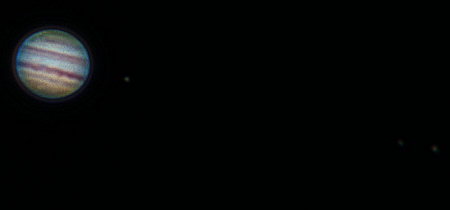
Hommel crater
Posted in Astrophotography with tags 150/750, afocal, Asclepi, Casio Exilim EX-FS10, crater, digicam, Hommel, Moon, Nearch, Newtonian, no tracking, Paint Shop Pro, Photoshop, Pitiscus, point-and-shoot, shift-and-add, Telescope on 2009/08/10 by computerphysicslabHommel is a big crater with nice craterlets inside, a Clavius-style set, but smaller, measuring 76 miles (129 Km). It is located in the South-East area of the visible Moon face. This area is pledge of small craters. It is similar in appearance to the sand of a beach. Pitiscus, Nearch and Asclepi are some of its neighbors.
The picture was taken at 19 days of lunation, that is 4 days after full Moon. This is the best timing to get sharp images of the crater’s walls’ shadows. The image is an integration of 27 subframes, each one taken at 9 Megapixels single shots with point-and-shoot digicam Casio Exilim EX-FS10.

Mare Crisium & Tranquillitatis
Posted in Astrophotography with tags 150/750, afocal, Astronomy, Canon EOS 450D, Lu, Mare Crisium, Mare Tranquillitatis, Moon, Newtonian, no tracking, Paint Shop Pro, Proclus, Rebel XTi, Reflex, Registax, shift-and-add, Telescope on 2009/08/08 by computerphysicslabTwo days after full moon Mare Crisium shows a nice landscape of mountains and shadows. Some of its inner crates are visible in this picture. The small crater Swift is on the limit of visibility. The big impact called Proclus and its rays are remarkable.
To take this image I used the Canon EOS 450d, Rebel XTI DSLR camera recording video subframes and later I stacked them up with Registax 5. Some small tweaks on Paint Shop Pro 9 and ready.
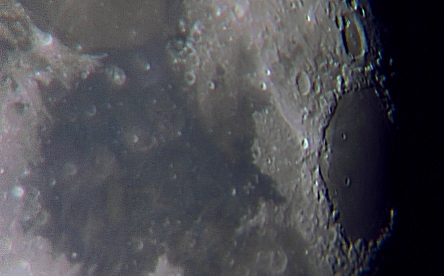
Full Moon
Posted in Astrophotography with tags 150/750, Astronomy, Canon EOS 450D, Canon EOS Rebel XTi, Full Moon, Newtonian, no tracking, Reflex, Registax, saturation, shift-and-add, Telescope on 2009/08/06 by computerphysicslabIn order to catch the Moon, I took 4 single shots at prime focus through my 150/600 telescope. As I lack of a T-mount adapter I had to take them in handheld mode. After de-rotating them accordingly, I stacked them up with Registax 5 and removed the noise a little bit. I used the body camera Canon EOS 450d (Rebel XTi) at high resolution, low sensitivity (ISO 100) and high shutter speed 1/2000. This is the result after a blow up in saturation:

Jupiter occultation of 45 Cap
Posted in Astrophotography with tags 150/750, 45 Cap, afocal, Astronomy, Bright star, Casio Exilim EX-FS10, Jupiter, Newtonian, no tracking, occultation, Registax, shift-and-add, Telescope on 2009/08/04 by computerphysicslabJupiter occultation of 45 Cap tonight:
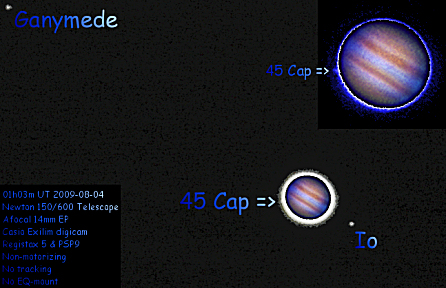
Jupiter with Exilim, 450d & Webcam
Posted in Astrophotography with tags 14mm, 150/750, afocal, Astronomy, Canon EOS 450D, Casio Exilim EX-FS10, Eyepiece, GRS, Jupiter, Newtonian, no tracking, Philips, Rebel XTi, Registax, shift-and-add, Telescope, ToUcam Pro, webcam on 2009/08/03 by computerphysicslabHere I have integrated my best images of Jupiter taken with 3 different cameras:
* Casio Exilim EX-FS10
* Canon EOS 450D (Rebel XTi)
* Webcam Philips ToUcam Pro
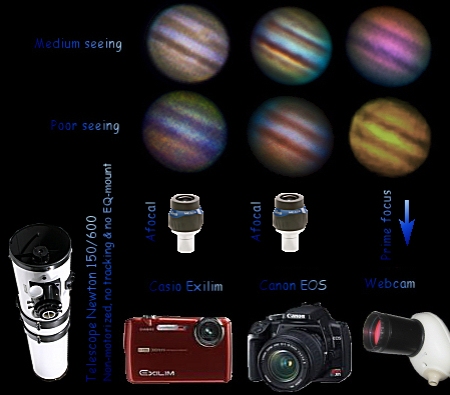
Voyager I vs. Newton 150/600
Posted in Astrophotography with tags 150/750, Astronomy, Jupiter, Newtonian, Telescope, Voyager I on 2009/07/30 by computerphysicslabTrying to find out which are the best colors and contrast to apply to a Jupiter I have come out with this comparative picture, between what Voyager I spacecraft could see and what I could spot last night with my humble newtonian telescope.

Jupiter post-processing
Posted in Astrophotography with tags afocal, Astronomy, Casio Exilim EX-FS10, good seeing, Great Red Spot, GRS, Jupiter, Newtonian, no tracking, Paint Shop Pro, Registax, shift-and-add, Telescope on 2009/07/29 by computerphysicslabI have been lucky tonight. Good seeing to see Jupiter. Using a small binoculars between the eyepiece and my eye I could spot visually Jupiter in high definition at an effective 450x magnification. That’s pretty good for a 150/600 reflector, isn’t it?
As you may appreciate in the following picture, the GRS (Great Red Spot) is clearly visible near the center of the planet. Several details are visible in the Jupiter’s bands. The image was obtained with a non-tracking Newtonian 6-inch telescope, a 14mm eyepiece, a Casio Exilim EX-FS10 digital camera that recorded 165 subframes. Registax 5 dealt with the alignment and stacking process. Dyadic Wavelets were applied to get contrast and details. PSP9 did the post-processing. The footage was taken exactly at 2009-07-28 03:33 UT.
Here several post-processing results are shown. The first one is that I like more.
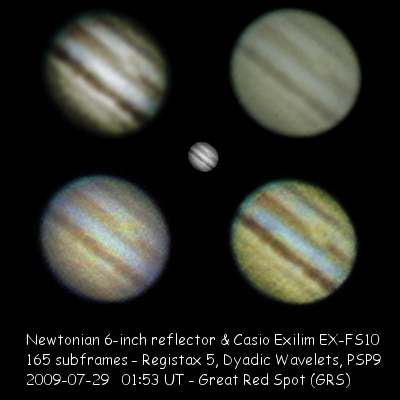
My best Jupiter so far
Posted in Astrophotography with tags 6 inches, Astronomy, Jupiter, Newtonian, no tracking, Philips Toucam Pro, Reflector, shift-and-add, Telescope, wavelets, webcam on 2009/07/26 by computerphysicslabMy 6-inch reflector working over a photographic tripod, and a webcam recording the focal plane. This is the resulting image, once overprocessed, yes, I give you that.
With Registax 5 I stacked 150 subframes and then applied dyadic wavelets. Some retouching with Paint Shop Pro 9 and fractal zooming under Photoshop.
The footage corresponds to 2009-07-26 at 01:44 UT.
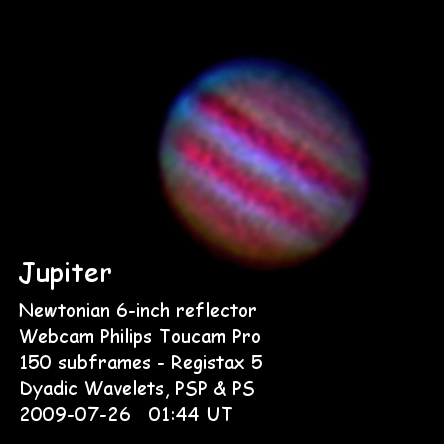
Meade Lightbridge smoothness
Posted in Astrophotography with tags Dobsonian, Meade Lightbridge 16", Newtonian, no tracking, Reflector, Telescope on 2009/05/05 by computerphysicslabHi CPL,
Thanks for posting that cool vid of the 16″ Lightbridge. I just spoke with someone at a telescope store who said they were looking to get rid of their 12″ Lightbridge because they said it is very shaky when viewing, and gives an unstable image.
I just was in a shop which had an 8″ Lightbridge and I would describe it as very smooth and rock solid.
Can I ask you if you’ve had any shaky or bouncing issues with your 16″?
I’m thinking of the 12″ for myself!
Thanks, PK
—————————————————————————————-
Meade Lighbridge does not come with slow motions for altazimuth movements. If you compare the movement of the Lightbridge with that of a tripod mounted refractor, for example, probably the tripod mounted is going to be much precise.
Nevertheless, it depends too much on what kind of observation are you planning. Watching the Moon, Lightbridge may became very smooth and exact in movement, because you always have a bright lunar surface all over the field of view and the movement you apply to the optical tube is constantly compared to the drift as seen through the eyepiece. On extensive deep sky objects, the same happens. The most difficult objects to track are planets, because the surrounding field of view is pitchblack and you lose any references once the planet gets out of the field.
If you try to use high power eyepieces with small apparent field of view with a planet, the lack of equatorial mount and a sideral motor drive may become a nightmare. In this cases, my advice is to always use widefield eyepieces and reduce the magnification if necessary.
To get a smooth movement it is important to balance correctly the optical tube, adding some magnets at the bottom side of the tube, near the mirror. Do not forget to check that the base of the dobsonian mount is not tilted. Following these advices, the telescope will have a very smooth movement in both axis, as shown in my video at http://www.youtube.com/watch?v=WWUGCk0wN24
The tracking becomes more difficult as longer the focal length. So Meade Lightbridge 16″ is the most difficult to track, because a slight movement in your hands transforms in a great movement in the field. Lower aperture telescopes, have less focal distance and apparent movements in the field are smoother.
If you are planning the use of the telescope for observational purposes, you won’t have any problems with the smoothness of the tracking once you get trained in several sessions. If you plan to do astrophotography, dobsonian movement may become a problem. Nevertheless, I do astrophotography of Moon, planets, and stars through my Meade Lightbridge 16″. You may check it out at my webpage: https://computerphysicslab.wordpress.com/
My final advice is: if you have previously be using regularly a smaller scope doing astronomy, you won’t find any problem using any of Meade Lightbridge series. Collimation is an important point to deal with in this scopes, but the quality of its elements is superb, and the price is really good.
